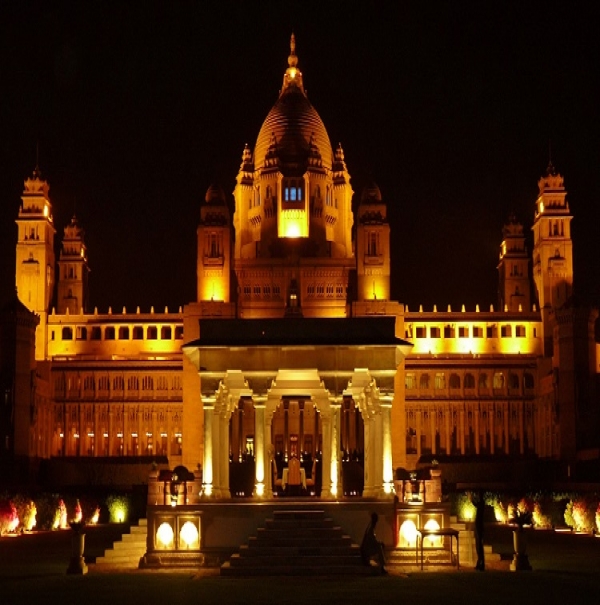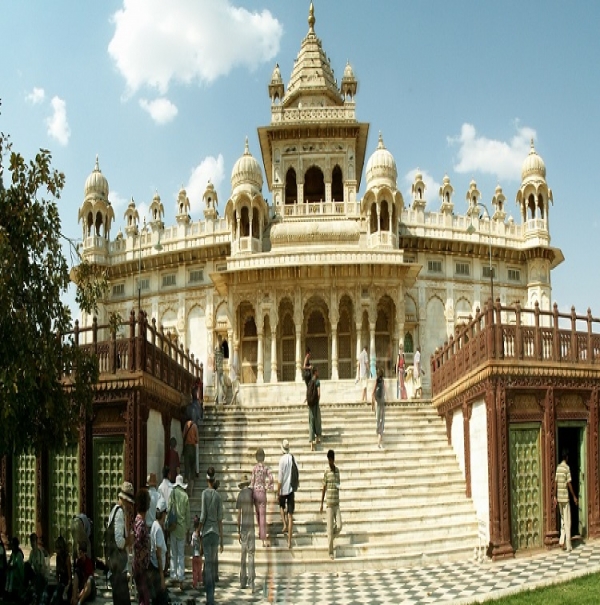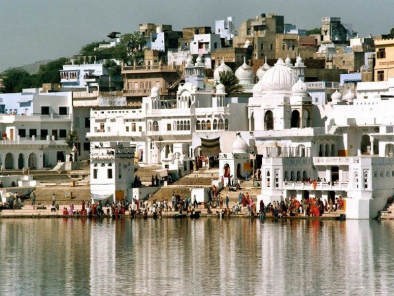
Sign Up
Already a member? Login
Rajasthan which is also known as the “Land Of maharajas”. The glory of the state is retained by its majestic places, forts and monuments. The vibrant culture and rich heritage of this princely state draw innumerable tourist from across the globe. Its major attractions include the Dilwara Temple, National Park, Forts, Lake Palaces, Deserts, Haveli, Temples, Food, Puppet Shows, Shopping, Fairs & Festival, Art and Culture, Folk Dance, Flora & fauna etc.

On arrival at Udaipur you will be transfer to your hotel. Udaipur is known as the Venice of the East. It has to its credit some beautiful temples and gardens. It lies in the Girwa Valley amidst the Aravali hills of South Rajasthan. The City is considered a Romantic city with its lakes, gardens, temples and –an Oasis in the Thar Desert. Transfer to the Hotel & Check In Later enjoy Boat ride (On Direct Payment) on Lake Pichola. Lake Pichola derives its name from Pichola Village. MaharanaUdai Singh enlarged the lake after he founded the city of Udaipur. This picturesque 4 km long and 3 km wide lake encloses the Jag Niwas Island and the Jag Mandir. The City Palace extends along its eastern banks. Check in at hotel and after some rest proceed to Boat ride at Lake Pichola (on direct payment) Pichola was the name of a village that lent its name to the lake. The islands of Jagniwas and Jagmandir are housed in this lake. Along the eastern banks of the lake lies the City Palace. A boat ride in the lake around sunset offers a breath-taking view of the Lake and City Palace. Overnight at hotel

After breakfast Proceed to Udaipur local sightseeing visit to City Palace: One of the largest royal complexes in Rajasthan, the City Palace stands majestically on a promontory on the picturesque Lake Pichola. The complex boasts 11 constituents Mahals (palaces), with balconies, towers and cupolas, offering a breathtaking view of the lake and its surroundings. The Durbar Hall, which was used as a venue for formal occasions like state banquets and meetings, has most luxurious interiors highlighted by some of the largest chandeliers in the world. The Palace also houses a museum displaying a number of interesting artifacts. Jagdish Temple: Built in 1651 AD by MaharanaJagat Singh, Jagdish Temple is the largest and the most beautiful temple in Udaipur. Dedicated to Lord Vishnu, the temple is famous for its beautiful sculpted images and towering shikhara. The temple represents a fine example of Indo-Aryan architectural style. Sahelion ki Bari: The Sahelion-ki-Bari Garden was built in early 18th century AD as a retreat for ladies of the royal household to spend their time in leisure. The enchantingly beautiful Garden is famous for its lotus pool, fountains (in the shape of birds), lush green lawns, flowerbeds, and marble pavilions, offering a breathtaking view to visitors. Drive past FatehSagar Lake: The FatehSagar Lake is one of the most sparkling places to see in Udaipur. It is located in the north-western region of Udaipur and is the second largest artificial lake in the beautiful Udaipur city. It is surrounded by the massive Aravalli Hills and is well-known for the boating activities it offers. The lake is 44 feet at its deepest point and very serene. Tourists enjoy cycling or walking around the lake, especially in the evenings and there are many food stalls as well. Local Shopping Market: The ‘City of Lakes’ is a delight for shopping enthusiasts coming over from around the world. The local markets here have an alluring atmosphere and as soon as you enter a market, there’s absolutely nothing you would not want to buy. Udaipur is full of boutiques, shopping malls, and almost everything is available at a stone’s throw but the real charm lies in its dazzling local markets with beguiling handicraft items, ethnic jewellery, and authentic leather products. shopping in these markets is a lot more fun and lighter on the pocket than actually paying retail for similar items in big shopping malls and designer shops. Hatipol Market , BhatiyaniChohatta, Gulab Bagh Road, Bapu bazaar, Bada bazaar, Mochiwada etc. Overnight stay at hotel.
After breakfast check out from hotel and proceed for Jaipur via puskhar. Pushkar is an important centre of pilgrimage for Hindus. The place has a magnetic appeal with 400 temples that are blue white and a number of bathing ghats. The town resounds with chanting of prayers and religious songs, along with drums and gongs. Pushkar is a happy tourist attraction and the main marketing spot sells didgeridoos (Australian wind music instrument), scarves in tie and dye, to the mix of eager tourists flocking from the world over. Visit Pushkar Lake, Pushkar Lake is considered as the holiest lake in India. This water reservoir is enclosed by 52 ghats (personal ghats for 52 Maharajas of India) and 500 temples. According to a Hindu mythology, this lake was created by the fallen petals of Lord Brahma's lotus when he was destroying the demon Vajra Nabha. Lotus petals were struck at a particular place and water spurted from there giving it the shape of a pious. Also Visit Brahma Mandir - The temple is made of stone stabs and marble. The red-colored shikara is a distinguishing feature of the temple and it also has a hamsa bird motif. Pillared canopies decorate the entrance of the temple. The outdoor hall of the temple is known as the mandapa and the interior of the temple is called the garbha griha. The walls inside the temple are inlaid with thousands of silver coins on which the devotees have written their names which marks as a sign of their offering to Lord Brahma. Later continue drive to Jaipur. On arrival check in into hotel. Overnight stay at hotel.

After breakfast proceed to local sightseeing. Amber Fort with Elephant or Jeep ride (At your own cost). The Amber Fort was built in 1592 by Raja Man Singh, is one of the finest examples of Rajput architecture. It gives extensive views over a deep narrow valley and the wider plains beyond. En route, make a photo stop at the palace of winds the Hawa Mahal. A 5 storied building with 25cm thick facade from the 18 century having 953 windows and niches so that ladies of royal family could see the procession and events in the city without being visible to the people. Later in the afternoon visit City Palace. The beautiful palace was built by Maharaja Sawai Jai Singh during his reign. Among the various forts and palaces of Jaipur, City Palace stands apart, with its outstanding art and architecture. City Palace complex covers a huge area, which is divided into a series of gardens, courtyards and buildings. The premises consists several buildings like Chandra Mahal, Mubarak Mahal, Mukut Mahal, Maharani's Palace, Shri Govind Dev Temple and the City Palace Museum. Also visit Jantar Mantar (1728-34) by king astrologer Jai Singh II. The instruments are built of stone with marble facing on the important plains for measuring the harmony of the heavens. Each instrument serves a particular function and each gives an accurate reading. Overnight stay.

Today morning after breakfast check out from Jaipur hotel and drive for Jodhpur - Set on the edge of the Thar desert, the imperial city of Jodhpur echoes with tales of antiquity in the emptiness of the desert. Once the capital of the Marwar state, it was founded in 1459 A.D. by Rao Jodha-chief of the Rathore clan of Rajputs who claimed to be descendants of Rama - the epic hero of the Ramayana. On arrival, Check in at hotel later proceed for visit to Umaid Bhawan Palace (Subject to time availability) Voted as the Best Hotel in the world, Umaid Bhawan Palace is also a major tourist attraction in Jodhpur. Apart from being a heritage hotel, it is a museum and the residence of the Royal Family of the present owner, Raja Gaj Singh. Because of its location on the highest point in Jodhpur, the Chittar Hill, it is also referred to as the Chittar Palace. Overnight at hotel.

After breakfast proceed for sightseeing. You can Visit the magnificent Mehrangarh fort which dominates the town ringed with its massive protective walls. There are seven gates that lead into the fort. Inside the fort is a series of courtyards and palaces. The palace apartments with marvelously carved panels, latticed windows have evocative names such as Sukh Mahal (Pleasure Palace), Moti Mahal (Pearl Palace), the Phool Mahal (Flower Palace) and the Sheesh Mahal (Palace of Mirrors). These palaces house a fabulous collection of trappings of Indian royalty including a superb collection of palanquins, elephant howdahs (used when the Maharajas rode their elephants in processions), miniature paintings, musical instruments and costumes. Continue your tour to Jaswant Thada, located a short distance from the fort, just off the fort road, is a white marble memorial to Maharaja Jaswant Singh II. The cenotaph built in 1899, was followed by the royal crematorium and three other cenotaphs that stand nearby. Rest of the day is free for shopping / Own activities. Overnight in the Hotel.
After breakfast check out from hotel and proceed to Jodhpur Airport/ Railway station. End of the trip with sweet memories.

Destinations
Pushkar, Jaipur
STARTING FROM
INR 12,499